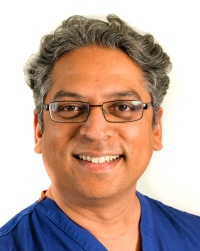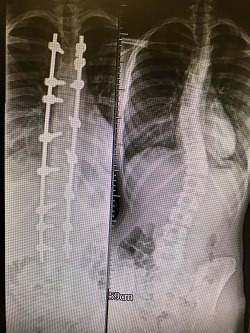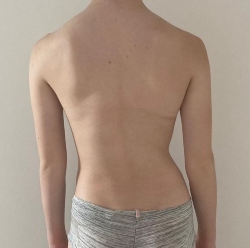Scoliosis in Teenagers - Lola’s Story.
Scoliosis - a curvature of the spine, is often not detected early enough in young people because it normally occurs around puberty when the body is changing, and a major growth spurt occurs.

That was the case for 14-year-old Lola Hill who had been complaining for about six months prior to her diagnosis of neck pain.
As Lola’s mother Leanne explains: “Every time it happened, Lola couldn't move for a few seconds, it seemed to be a very painful spasm or a trapped nerve. I just kept saying that it was due to growing pains.”
“One day she came home from school and told me her neck had frozen again and the pain had made her cry. As we hadn’t noticed anything out of the ordinary, I thought it was time to visit a specialist.”
The Hill family made an appointment with Consultant Orthopaedic Spinal Surgeon, Mr Almas Khan at Nuffield Health Leeds Hospital and during the consultation, he noticed that one of Lola’s hips was sticking out more than the other. Following an x-ray, he diagnosed a curvature of the spine.
Lola had noticed it but put it down to bodily changes that girls go through.
We hadn’t noticed anything curved on her spine because she's at that age where you don’t often see her body and due to the winter weather Lola was always wrapped up well.

“The news was a bombshell. I went home and cried for not knowing my daughter had scoliosis and not noticing it. After that, I read up on the internet and Mr Khan was incredibly good in pointing out websites to research further information,” Leanne Hill said.
Picking up the story Mr Khan said: “It’s important to notice any body changes when adolescents are having growth spurts as they can cause quite a visible deformity as they worsen and may lead to psychological effects on patients, often causing them to become withdrawn. It affects their interaction with society and impacts their self-confidence.
“For mild to moderate curves, once people stop growing their curve doesn’t tend to get worse but once the curve gets beyond a certain severity, even after they have stopped growing, it can continue to worsen later on in their life. This means if things have progressed, and a patient decides to have an operation later on in life, it becomes more risky and takes longer for the patient to get over the operation in a reasonable way.”
In terms of post-operative recovery Mr Khan says the best time to have spinal surgery is when young people are coming towards the end of their growth spurt because all the growth potential in the body can be converted to healing capability which enables a quicker recovery.

The Hill family, fortunately, had private health insurance and so the operation was able to take place at Nuffield Health Leeds Hospital, one of a few places where this surgery is carried out, as it requires children's critical care provision and a focus on relatively resource intensive procedures like nursing and clinical input. As a purely elective environment, strict COVID precautions meant that these risks could be controlled effectively.
There was a slot available, and Lola successfully had her operation within a brief period after visiting Mr Khan.
Lola is looking forward to playing golf again and the first time she can pick up her clubs. She already anticipates regularly beating her dad and taking part in competitions.
“It was just unbelievably so fast and the care we received right across the board from housekeepers to nurses - everybody was second to none. I would advise anybody to go to Nuffield Health Leeds Hospital, the care we received was outstanding, I couldn’t thank everyone enough.”
“I found out loads of information about how to get ready and prepare for my daughter’s surgery. I was prepared for the surgery but not the recovery time.

“For all mums like me, do reach out to other parents so you can get the personal perspective. I would be willing to talk to other mums,” Leanne Hill said.
Lola is noticeably more confident and proud of her scar, always willing to show it off especially as four months on she doesn’t have any back pain.
Because of her confidence, Lola has been reaching out to young people through social media helping those who are also about to undergo their spinal operation at Nuffield Health Leeds Hospital.
Her mother is proud of the way she conquered any worries and for a 14-year-old even the nurses and physiotherapists kept saying: “If every patient was like you, they would fly through this.”
Scoliosis: what to look out for:
For parents who have adolescent children they should be looking out for changes in the shape of their child's waist, differences in shoulder symmetry and looking to see if their ribs are more prominent on one side more than the other. Sometimes this can be more noticeable when leaning forward.

The earlier a curve is picked up the more options there are to treat it without an operation or preventing it from getting worse.
Curves tend to run in families, and small curves are often not easily detectable without an x-ray.
If there is any suspicion, then an x-ray of the whole spine is probably required. Often physiotherapists and GPs are reasonably familiar with these types of cases and pick up any asymmetry so don't be afraid to get help at an early stage.
Mr Khan is keen to reiterate the point: “The earlier that someone presents it might actually prevent needing an operation.”
“Quite a lot of parents wouldn't necessarily think that such a big operation is available in the private sector. At Nuffield Health Leeds Hospital, we have the facilities and perform up to 20 scoliosis operations a year. We have worked hard to develop a really robust clinical pathway with dedicated consultants, experienced anaesthetists as well as paediatric and spinal specialist nurses,” Mr Khan concluded.
